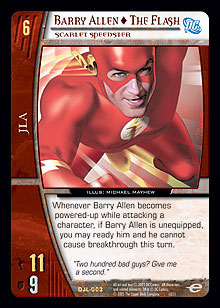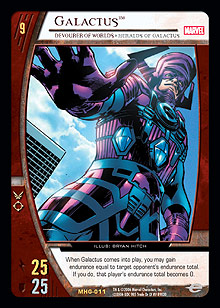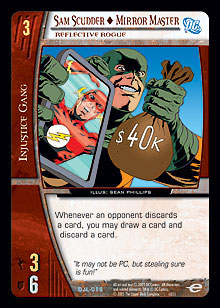One of the undeniable highlights of Vs. System is the fantastic Organized Play structure we have. The framework provides a solid and accessible learning curve that runs from the Hobby League at your local store right up to the pinnacle of play at the Pro Circuit. Vs. System OP is the reason that many of us actually got into the game in the first place, and it provides a continuous quest for those with aspirations of Vs. greatness.
This does not apply to everyone, though. In my local environment, I am the only player who’s interested in climbing the OP ladder. Everyone else is just in for the fun, which is not a bad thing by any stretch of the imagination. I don’t know if it’s the same with your local casual crowd, but sometimes the players find that they need a break from the usual formats of sanctioned events. Steak is delicious, but you don’t want to eat it every day; sometimes you want a little chicken. With that in mind, we’re always on the lookout for new, alternative ways to play the game. Here are some of the alternate formats I’ve stumbled across over the years—if you feel like trying something new, give one of these a go.
Pauper
In Pauper format you’re restricted to building your deck with no rares at all. You may include a maximum of eight uncommon cards, but everything else has to be of the common variety. This format is particularly good for bringing new players into the game. (We don’t all have a play set of Savage Beatdown, Enemy of My Enemy, and Mobilize.) By restricting the card pool in such a way, you ensure that the players who have not yet had time to build a large portfolio of Vs. cardboard can compete with the long-time collector. It’s really a great leveler of the playing field, and something I would highly recommend.
Speedster Vs.
 This format just happened by accident. I was at a weeknight tournament at my local store. Things were going well, and I worked my way through to the finals. The only problem was that time was against us; we had a best-of-three match ahead of us, and it was already 11:00 PM. Although we were playing the game in a very friendly, casual manner and both of us were getting quite tired, neither my opponent nor I wanted to concede. The game was on, but what we agreed to do was place drastic time limits on our turns. On your initiative, you have just two minutes to complete your entire turn. (The game requires an additional person to keep score, monitor time, and also shuffle the players’ decks so the main guys can get on with playing the game.) Playing the game at such a frenetic pace is really quite a challenge. You don’t have the time to analyze every possible move and counter-move. You fly by the seat of your pants—and sometimes you crash and burn—but the ride sure is a lot of fun.
This format just happened by accident. I was at a weeknight tournament at my local store. Things were going well, and I worked my way through to the finals. The only problem was that time was against us; we had a best-of-three match ahead of us, and it was already 11:00 PM. Although we were playing the game in a very friendly, casual manner and both of us were getting quite tired, neither my opponent nor I wanted to concede. The game was on, but what we agreed to do was place drastic time limits on our turns. On your initiative, you have just two minutes to complete your entire turn. (The game requires an additional person to keep score, monitor time, and also shuffle the players’ decks so the main guys can get on with playing the game.) Playing the game at such a frenetic pace is really quite a challenge. You don’t have the time to analyze every possible move and counter-move. You fly by the seat of your pants—and sometimes you crash and burn—but the ride sure is a lot of fun.
Big Deck
The Big Deck format is the brainchild of Pro Circuit Champion Adam Prosak. The rules as laid down by our reigning champ are as follows:
· Your deck must contain at least 100 cards, including one copy of UN Building.
· You cannot play more than one copy of any card.
· You must play at least four different team affiliations and at least ten characters from each of the four affiliations.
· At the beginning of each game, after resolving mulligans, you can put your UN Building into your hand. Effectively, you will start with a five-card hand that contains a UN Building.
· The more EA cards in your deck, the better. The more scribbled-on cards in your deck, the better.
· Don’t run tech cards. No Unmasked, no Phantom Zone. Flame Trap is iffy. You can’t win $40,000 playing this format . . . yet.
· The ban list is exactly one card: Enemy of My Enemy. If you want to draw your one Overload to combo with your one Savage Beatdown, then go for it. Use Justice League of Arkham to make your opponent discard a card, but don’t play an Enemy.
Thomas Reeve featured the Big Deck format in a recent Deck Clinic right here on Metagame.com, so for more information, pop along to his article and get the expert lowdown on how it’s done—big!
Super Villain Smackdown
 This is probably my favorite format of the lot. Erick Reyes over at Edgeworld in Costa Mesa, California was inspired by the event deck from the Onyxia’ s Lair Raid Deck for the World of Warcraft TCG. He suggested adapting the framework into a usable Vs. System format, and along with Patrick Yapjoco, Joe Bryan, and Metagame.com’s very own Billy Zonos, he began to flesh out the specifics of a very—and I mean very—entertaining format. After some initial testing, the guys decided to bring in the larger community of VSRealms.com and turn it into a sort of “open source” session where anyone could contribute to the development.
This is probably my favorite format of the lot. Erick Reyes over at Edgeworld in Costa Mesa, California was inspired by the event deck from the Onyxia’ s Lair Raid Deck for the World of Warcraft TCG. He suggested adapting the framework into a usable Vs. System format, and along with Patrick Yapjoco, Joe Bryan, and Metagame.com’s very own Billy Zonos, he began to flesh out the specifics of a very—and I mean very—entertaining format. After some initial testing, the guys decided to bring in the larger community of VSRealms.com and turn it into a sort of “open source” session where anyone could contribute to the development.
For those of you who are not familiar with the Onyxia’s Lair Raid Deck, the basic idea is that you have a “super player” who stands alone against a minimum of three other players. Here is a basic outline of the rules (remember, these are just guidelines, so feel free to tweak them to your taste):
Players
One player is designated the Super Villain (or Super Hero if you like), and a minimum of three players make up the “Opposition.” The three Opposition players all use standard Constructed decks, but the Super Villain player builds his/her deck in a very different, three-part manner:
The “Super” Character Deck
The Super Player builds a nine-card deck that is made up of characters of incrementally increasing recruit cost: one character should be included at each drop from 1-8, and then either a 9-drop or another 8-drop. All characters in this deck must share at least one printed team affiliation, but unaffiliated characters may be used and are assumed to have the same team affiliation as the other “super” characters.
The Event Deck
The event deck is a separate deck that is used to fuel the Super Player’s resource row. The event deck may only contain locations, ongoing plot twists, and normal plot twists that can only be played from the resource row. Plot twists that simply gain additional benefits by being played from your resource row may not be included in your event deck. For example, you may include Inspiring Demise, but you may not use Die for Darkseid! in your event deck. Lastly, all cards in your event deck are non-unique.
The Battle Deck
The battle deck is built in exactly the same way as a normal Constructed deck, but the Super Player may not include any copies of the characters that have been used in the Super Character deck.
Gameplay Rules
Super Player
1. The Super Player cannot be the target of effects controlled by any Opposition player.
2. The Super Player always has the initiative.
3. The Super Player can only be attacked directly if he controls no visible characters or super characters.
Super Characters
- Super characters are not unique.
- At the start of his or her recruit step, the Super Player puts a super character into play. That character must have a recruit cost equal to or less than the current number of resources controlled by the Super Player.
- Super characters do not have to meet recruit costs like loyalty or discards.
- When a super character comes into play, the Super Player gains 10 endurance.
- Super characters always come into play in the visible area—even if they have the concealed keyword.
- A super character may not be moved into the hidden area by any effect controlled by any player.
- Super characters may not be removed from play by abilities controlled by the Opposition players.
- The super character that came into play most recently is the only one that is allowed to attack. Other super characters may be used to pay the cost of powers and use their own powers, but they may not attack.
- Super characters come into play in the super character zone, which has a front row and support row. This zone is separate from the normal “in-play zone.” Super characters are never adjacent to other characters controlled by the Super Player.
- If there are multiple super characters in play, they stack on top of each other in cost order with the lowest cost at the bottom. A super character cannot protect or reinforce another super character.
- An Opposition player cannot attack a super character before turn 4. Any attack that would otherwise target the super character on turns 1-3 is considered a direct attack on the Super Player.
- An Opposition player may only attack a super character if the Super Player controls no other non-stunned characters.
- When attacking a super character, an Opposition player must attack the lowest-cost super character in play.
- When a super character becomes stunned, it is immediately removed from the game.
- When a super character becomes stunned, the Opposition player responsible gains 10 endurance.
The Event Deck and Resources
- At the start of every resource step, the Super Player puts the top card of his event deck face down into his resource row. These cards can be flipped at any point when the Super Player has priority and has sufficient resources to meet the threshold cost of that card.
- Cards in the Super Player’s resource row are not unique.
- If a resource controlled by the Super Player would be replaced, the top card of the event deck is used for the replacement.
- Resources controlled by the Super Player cannot be KO’d. If an effect would KO a resource controlled by the Super Player, that resource is replaced instead.
- The event deck may not be targeted, searched, or otherwise affected by any effects controlled by any player. Whenever a player controls an effect that requires interaction with the Super Player’s deck, that card is deemed to refer to the battle deck. For example, if an Opposition player plays Time Thief, upon resolution, the Opposition player would search the Super Player’s battle deck.
The Battle Deck
The battle deck and cards within the battle deck follow exactly the same rules as a normal Constructed deck.
Starting the Game
- The Super Player always starts the game with the initiative.
- The Super Player begins the game with 40 endurance.
- The Super Player draws four cards from the battle deck and then has the opportunity to mulligan. The Super Player does not draw an additional two cards after the opening four.
- The Opposition players start the game under normal Constructed rules (50 endurance, normal card draw and mulligan rules).
Draw Phase – Super Player
Instead of drawing the normal two cards per turn, the Super Player draws cards from his or her battle deck equal to the number of resources he or she controls.
Build Phase – Super Player
1. Resource step. At the start of the Super Player’s resource step, that player puts the top card of his or her event deck face down into his or her resource row.
2. Recruit Step. At the start of the Super Player’s recruit step, he or she puts a super character into play that has a recruit cost less than or equal to the number of resources he or she controls. During the recruit step, the Super Player may recruit normal characters from his or her hand under normal game rules.
3. Formation Step. During the formation step, the Super Player may move his or her super character to the front or support row of the super character zone. If there are multiple super characters in play, for the duration of the formation step, they are considered one entity and share the same space in the super character zone (they stack on top of each other with lowest cost at the bottom). Characters in the in-play zone are formed up under normal game rules.
Combat Phase – Super Characters
- The Opposition players can only attack a super character if the Super Player controls no visible, non-stunned characters.
- The Opposition players may only attack the Super Player directly if the Super Player controls no visible, non-stunned characters (including the super characters).
- If there are multiple super characters in play and the Opposition player would attack a super character, the lowest-cost super character in play must be the target of that attack.
- If there are multiple super characters in play, the Super Player may only declare an attack with the highest-cost super character.
- When a super character is stunned, the Opposition player responsible gains 10 endurance.
Winning and Losing the game
- Whenever a player reaches 0 (or less) endurance, he or she is instantly removed from the game.
- If all Opposition players are removed from the game, the Super Player is declared the winner.
- If the Super Player is removed from the game, the Opposition players are declared the winners.
These rules are not set in stone, so feel free to change them to suit your own desires. The format is picking up a cult following, and I’ve been told that Game Empire in Pasadena, California actually holds weekly events for the format.
Alternate formats are a great way to enjoy the game on a different level than the normal OP style of event. Try some of these out—I’m positive you’ll have a blast!
 Deckbuilder Challenge Cup
Deckbuilder Challenge Cup
We’re running a week behind schedule thanks to the Marvel Team-Up previews from a couple of weeks ago, but we’ll let that slide, considering the quality of the stuff we were reading during the buildup.
While we wait for the results of the last challenge to come in, I’m going to go right ahead and set challenge #9. For this challenge, I’m going to revisit a theme we used for one of the first DBCCs: the No Rare deck.
DBCC #9: “Pauper Revisited”
Pauper format was one of the first DBCCs I ran, but as the card pool has drastically increased since then, I think we can revisit the challenge and see if we can come up with some interesting alternatives.
The Rules:
· Minimum 60-card deck.
· No rares allowed.
· Only 8 uncommon cards are allowed.
· All cards are legal—the ban list does not apply.
· You must name your deck.
· Please include a paragraph of description with your deck submission.
· Closing date is Sunday, February 25th.
You can submit your decks by emailing me at my new email address (kamiza@the-kamiza.com) or by posting your submission on my website (www.the-kamiza.com).
Steve “Kamiza” Garrett has been an active member of the vast Vs. System online community since day one. Steve is an ardent supporter of casual Vs. play and the European game on the whole. If you are interested in supporting UDE games within Europe or have any comments regarding this article, please pop along to his website: www.the-kamiza.com